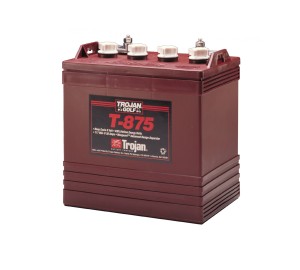
Caring for the batteries in your golf cart is easier than you may think, and will result in a longer battery life. Here are a few tips, courtesy of Trojan Batteries.
EQUIPMENT:
There are many tools that may help in properly caring for and maintaining golf cart batteries. Here are some of the recommended tools and supplies to get you started:
Goggles & Gloves
Distilled Water
Hydrometer
Voltmeter
Vaseline
Post Cleaner
Baking Soda
CAUTION: Always wear protective clothing, gloves and goggles when handling batteries, electrolyte, and charging your battery.
Batteries should be carefully inspected on a regular basis in order to detect and correct potential problems before they can do harm. It is a great idea to start this routine when the batteries are first received.
INSPECTION
1. Examine the outside appearance of the battery.
- Look for cracks in the container.
- The top of the battery, posts and connections should be clean, free of dirt, fluids, and corrosion. If batteries are dirty, refer to the Cleaning section (below).
- Repair or replace any damaged batteries.
2. Any fluids on or around the battery may be an indication that electrolyte is spilling, leaching, or leaking out.
- Leaking batteries must be repaired or replaced.
3. Check all battery cables and their connections.
- Look closely for loose or damaged parts.
- Battery cables should be intact; broken or frayed cables can be extremely hazardous.
- Replace any cable that looks suspicious.
4. Tighten all wiring connections to the proper specification. Make certain there is good contact with the terminals.
WARNING: Do not overtighten terminals. Doing so can result in post breakage, post meltdown, or fire.
CLEANING
Batteries attract dust, dirt and grime. Keeping them clean will help you spot trouble signs if they appear, and avoid problems associated with grime.
- Check that all vent caps are tightly in place.
- Clean the battery top with a cloth or brush and a solution of baking soda and water. When cleaning, do not allow any cleaning solution, or other foreign matter to get inside the battery.
- Rinse with water and dry with a clean cloth.
- Clean battery terminals and the inside of cable clamps using a post and clamp cleaner. Clean terminals will have a bright metallic shine.
- Reconnect the clamps to the terminals and thinly coat them with petroleum jelly (Vaseline) to prevent corrosion.
- Keep the area around batteries clean and dry.
WATERING (flooded batteries only)
Golf Car batteries need water. More importantly, watering must be done at the right time and in the right amount or the battery’s performance and longevity suffers.
Water should always be added after fully charging the battery. Prior to charging, there should be enough water to cover the plates. If the battery has been discharged (partially or fully), the water level should also be above the plates. Keeping the water at the correct level after a full charge will prevent having to worry about the water level at a different state of charge.
Depending on the local climate, charging methods, application, etc., Trojan recommends that batteries be checked once a month until you get a feel for how “thirsty” your batteries are.
Important things to remember:
1. Do not let the plates get exposed to air. This will damage (corrode) the plates.
2. Do not fill the water level in the filling well to the cap. This most likely will cause the battery to overflow acid, consequently losing capacity and causing a corrosive mess.
3. Do not use water with a high mineral content. Use distilled or deionised water only.
CAUTION: The electrolyte is a solution of acid and water so skin contact should be avoided.
Step by step watering procedure:
1. Open the vent caps and look inside the fill wells.
2. Check electrolyte level; the minimum level is at the top of the plates.
3. If necessary, add just enough water to cover the plates at this time.
4. Put batteries on a complete charge before adding any additional water.
5. Once charging is completed, open the vent caps and look inside the fill wells.
6. Add water until the electrolyte level is 1/8 inch below the bottom of the fill well.
7. A piece of rubber can be used safely as a dipstick to help determine this level.
8. Clean, replace, and tighten all vent caps.
WARNING: Never add acid to a battery.
For a free Trojan battery user guide please contact Mark Ray from Alco Battery Sales:
Email Trojan@alcobatt.com.auu or visit www.alcobatt.com.au




![Win the golfing experience of a lifetime, at the Hawai‘i International Week of Golf, valued at $6,900 [Winner Announced] Win the golfing experience of a lifetime, at the Hawai‘i International Week of Golf, valued at $6,900 [Winner Announced]](https://www.insidegolf.com.au/wp-content/uploads/Hawaii-Comp-500x294.jpg)